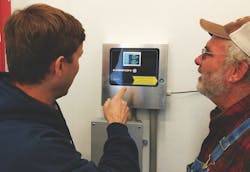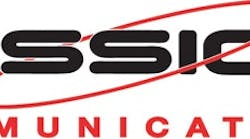Taylor Williams is marketing assistant for Mission Communications. Williams can be reached at [email protected].
For the better part of nine years, Vivian Shaw has been the operator of Chautauqua County Rural Water District #4 (RWD4) in Kansas. The utility distributes potable water to customers of Chautauqua and Montgomery counties, as well as the city of Longton, using approximately 275 miles
of pipeline.
Depending on the season, RWD4 provides 50,000 to 80,000 gal of water per year. Shaw carries the full responsibility of the utility on her shoulders—taking samples, managing water loss and detecting leaks. As such, she has little personal time. If she suspects a leak in the pipeline, she must wait until nighttime to search for it because customers using water often cause interference in small leak detection.
For the past three years, RWD4 has used Mission M110 remote terminal units (RTUs) to monitor the pipeline for leaks. The RTUs monitor three master meters, which track how much water is pulled from the water supplier, Public Wholesale #20. This technology streamlined Shaw’s daily responsibilities, freeing up time and money while providing peace of mind.
Removing Uncertainty
Louis Funk, project manager and vice president for Bartlett & West Engineers, is the consulting engineer for RWD4. He has been involved with RWD4 since planning began in the late 1990s and assisted in developing the three-phase construction plan that created RWD4.
The initial plan did not include any type of smart control or monitoring, but by the time the third phase of construction began, Shaw expressed the need for an easier way to find leaks on the existing phases.
“I recommended that we go into their existing pressure-reducing valve (PRV) vaults and convert them to a tandem meter setter because these were small, 2-in. valves,” Funk said. “I suggested that we put positive displacement meters in-line with those PRVs, and then take the signal from the meter to a Mission box and use cellular communication to be able to monitor it.”
In remote, rural areas, it often is difficult and expensive to run the power and phone lines that would be necessary for traditional SCADA and monitoring systems. The district installed three solar-powered M110 units that Funk said were the best options for RWD4 due to ability, simplicity and price point.
Prior to implementing the RTUs, Shaw’s job was more cumbersome.
“Before I got Mission RTUs, I was reading my master meters every day,” Shaw said. “I had to go out there and physically read it.”
The meters are spread throughout the area, and she was traveling more than 40 miles per day on gravel roads to check each of them, sometimes taking up to an hour and a half.
Additionally, the master meters only showed the previous day’s total usage, without timestamps to indicate when the water was being used. If the usage was particularly high, she had to determine whether it was because of a leak or a customer using more water than usual. Now she can access the web portal on her phone to check the flow to determine whether there is a leak.
“With Mission, I can see what happened during the night,” Shaw said. “I can see what those meters are doing every 15 minutes—all day and all night. And I can really look at them and study what I think might be going on.”
Shaw reports that the water loss for RWD4 has been in the 5% to 7% range since the system was installed, meaning of the total water RWD4 pulls from Public Wholesale #20, only 5% to 7% is lost in an average year. Shaw said this is nearly unheard of for rural water districts because of the seemingly endless expanse of pipeline. Lower water loss allows RWD4 to keep its water prices low, saving money for the utility and customers alike.
“I would recommend that any rural water district use this system to lower their water loss,” Shaw said.
Vivian Shaw’s work-life balance has changed dramatically since the installation of remote terminal units, as she no longer has to spend nights tracking down water loss data.
Peace of Mind
The system has not only saved RWD4 time and money, but also provided peace of mind. Determining whether a pipe had a leak used to be a frustrating process that involved a lot
of guesswork.
Before the RTUs were installed, Shaw said a high-pressure pipeline had just been installed and split open. The pipe lost several hundred thousand gallons as water shot 50 ft in the air. Luckily, a passerby saw the leak and called it in. Otherwise, the leak would have gone unnoticed until it completely drained
the reserves.
“The whole district would have been without water,” Shaw said. “But now that I have Mission, as soon as it had split open, Mission would have called me, and I would have gone on my web portal immediately to see what happened.”
The district encapsulates up to a dozen towns and about five smaller water districts. In situations like this, quick response is crucial. Knowing the system will notify her to issues as soon as they occur, Shaw can rest easy in her downtime—time she otherwise would not have had to herself.
Overall, her job is simpler and more efficient with the addition of the RTUs.
“It just makes your life a lot easier, and you have that peace of mind,” Shaw said. “If something goes wrong, it’s going to call you and tell you right away. Then you don’t have to worry about going out every day to read that meter. You can carry on with the other stuff that you need to do to operate your system.”



